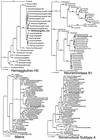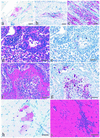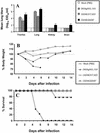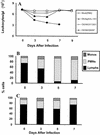Characterization of a highly pathogenic H5N1 avian influenza A virus isolated from duck meat
- PMID: 12021367
- PMCID: PMC136198
- DOI: 10.1128/jvi.76.12.6344-6355.2002
Characterization of a highly pathogenic H5N1 avian influenza A virus isolated from duck meat
Abstract
Since the 1997 H5N1 influenza virus outbreak in humans and poultry in Hong Kong, the emergence of closely related viruses in poultry has raised concerns that additional zoonotic transmissions of influenza viruses from poultry to humans may occur. In May 2001, an avian H5N1 influenza A virus was isolated from duck meat that had been imported to South Korea from China. Phylogenetic analysis of the hemagglutinin (HA) gene of A/Duck/Anyang/AVL-1/01 showed that the virus clustered with the H5 Goose/Guandong/1/96 lineage and 1997 Hong Kong human isolates and possessed an HA cleavage site sequence identical to these isolates. Following intravenous or intranasal inoculation, this virus was highly pathogenic and replicated to high titers in chickens. The pathogenesis of DK/Anyang/AVL-1/01 virus in Pekin ducks was further characterized and compared with a recent H5N1 isolate, A/Chicken/Hong Kong/317.5/01, and an H5N1 1997 chicken isolate, A/Chicken/Hong Kong/220/97. Although no clinical signs of disease were observed in H5N1 virus-inoculated ducks, infectious virus could be detected in lung tissue, cloacal, and oropharyngeal swabs. The DK/Anyang/AVL-1/01 virus was unique among the H5N1 isolates in that infectious virus and viral antigen could also be detected in muscle and brain tissue of ducks. The pathogenesis of DK/Anyang/AVL-1/01 virus was characterized in BALB/c mice and compared with the other H5N1 isolates. All viruses replicated in mice, but in contrast to the highly lethal CK/HK/220/97 virus, DK/Anyang/AVL-1/01 and CK/HK/317.5/01 viruses remained localized to the respiratory tract. DK/Anyang/AVL-1/01 virus caused weight loss and resulted in 22 to 33% mortality, whereas CK/HK/317.5/01-infected mice exhibited no morbidity or mortality. The isolation of a highly pathogenic H5N1 influenza virus from poultry indicates that such viruses are still circulating in China and may present a risk for transmission of the virus to humans.
Figures





References
-
- Alexander, D. J., W. H. Allan, D. G. Parsons, and G. Parsons. 1978. The pathogenicity of four avian influenza viruses for fowls, turkeys and ducks. Res. Vet. Sci. 24:242-247. - PubMed
-
- Alexander, D. J. 1993. Orthomyxovirus infections, p. 287-316. In J. B. McFerran and M. S. McNulty (ed.), Viral infections of vertebrates, vol. III. Viral infections of birds. Elsevier, Amsterdam, The Netherlands.
-
- Alexander, D. J. 2000. A review of avian influenza in different bird species. Vet. Microbiol. 74:3-13. - PubMed
-
- Bankowski, R. A. 1981. Introduction and objectives of the symposium, p. vii-xiv. In R. A. Bankowski (ed.), Proceedings of the 1st International Symposium on Avian Influenza. United States Animal Health Association, Richmond, Va.
-
- Barbeito, M. S., G. Abraham, M. Best, P. Cairns, P. Langevin, W. G. Sterritt, D. Barr, W. Meulepas, J. M. Sanchez-Vizcaino, and M. Saraza. 1995. Recommended biocontainment features for research and diagnostic facilities where animal pathogens are used. First International Veterinary Biosafety Workshop. Rev. Sci. Tech. 14:873-887. - PubMed
Publication types
MeSH terms
Substances
Associated data
- Actions
- Actions
- Actions
- Actions
- Actions
- Actions
- Actions
- Actions
- Actions
- Actions
- Actions
- Actions
- Actions
- Actions
- Actions
- Actions
- Actions
- Actions
LinkOut - more resources
Full Text Sources
Other Literature Sources
Medical
Research Materials

